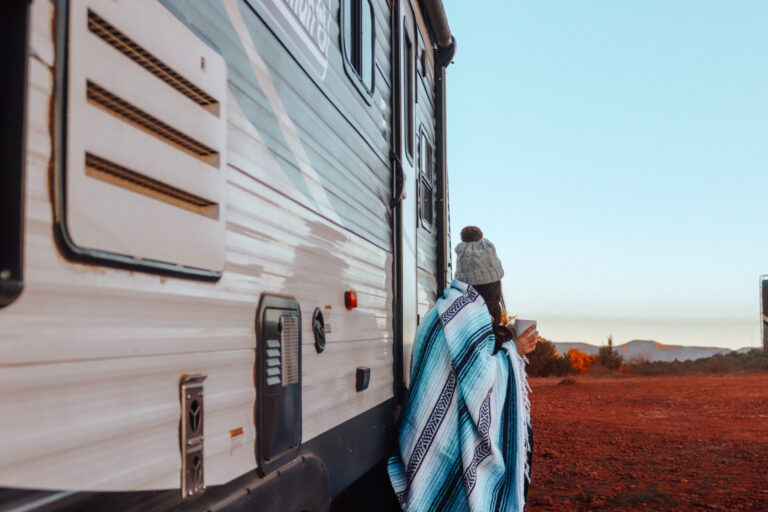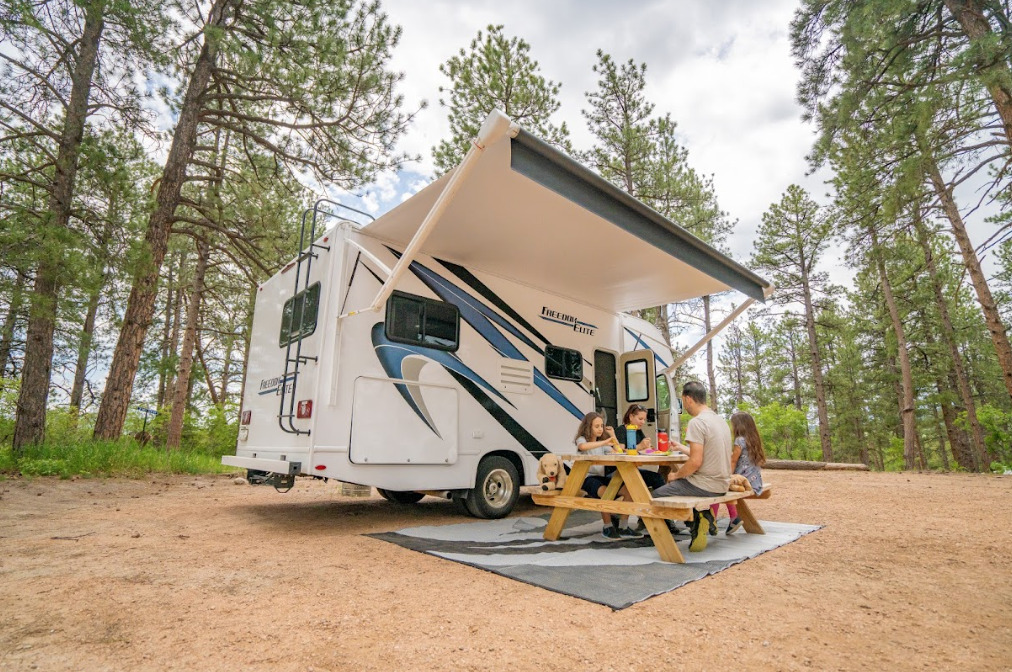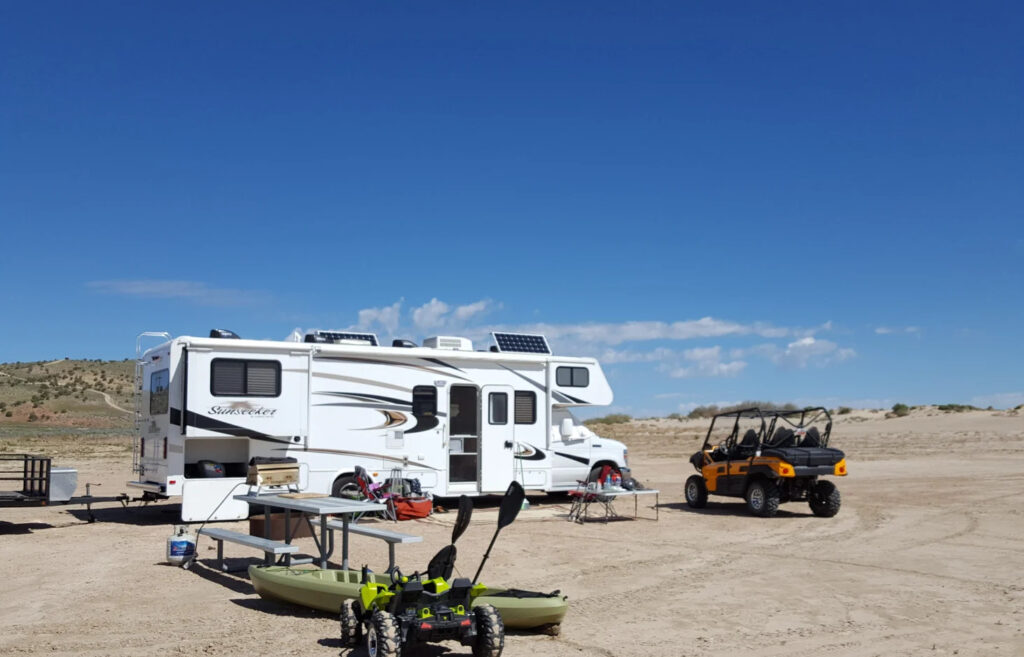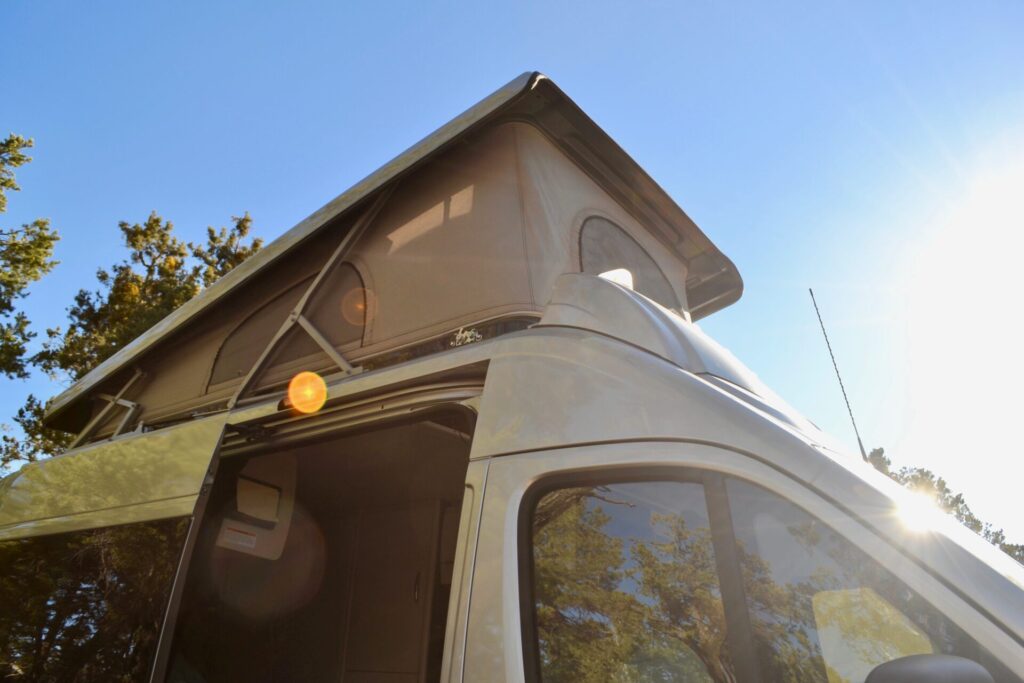
Boondocking – a type of dry camping – is the best of both worlds when you’re an RVer. You’re off the grid, away from crowds, noise, and stress. You’re out in nature. But boondocking doesn’t mean living off canned food heated over a fire like with traditional camping — you can do it with some creature comforts including a warm, soft bed and electricity. Perfect! But of course, if you want that electricity to last for your trip, you’ll need a good boondocking battery setup.
In this article, we’ll cover the best RV batteries for boondocking including the different types to choose from, methods of charging your RV battery while off-grid, and how to conserve power.
Best RV Battery for Boondocking
As with most RV equipment, the best RV battery for dry camping will depend on a few variables. The best RV battery for boondocking may be different for someone else than it will be for you.
To determine the best RV battery setup for you, you’ll need to know how many amps each of your appliances use while they’re plugged in.
It might be a good idea to keep a record before a long trip. Small appliances like lights and music won’t be too much of a drain, but if you’re using a microwave, electric kettle, or coffeepot, you’ll need a lot more amp hours. Don’t forget to factor in a heater as well if you plan to use one.

Different types of RV Batteries
RVs need 12 volts to power things like your fridge, lights, and bathroom fan. You can have either one 12-volt battery, or 2 or more 6-volt batteries wired together in a series or parallel. Connecting multiple batteries can give you more amp hours. How many batteries you’re able to add to your bank will depend on the amount of storage space you have available and your cargo-carrying capacity, but generally speaking, the more you can fit and afford (both weight- and money-wise), the better off you’re going to be.
While 12-volt batteries are usually cheaper than 6-volt batteries, they don’t last as long and can’t be discharged and recharged as often. These batteries are fine for people who will generally use hookups, but they’re not the best option for long boondocking trips.
Lead-Acid Deep Cycle RV Batteries
This is the most common RV battery, made of lead plates submerged in an electrolyte solution that is a combination of sulfuric acid and water. They come in 6- and 12-volt sizes. The size of the lead plates and the amount of electrolyte solution determines the charge a battery can store. Be sure you’re using a deep-cycle battery for your RV, as they can discharge more fully than other lead-acid batteries.
Lithium-Ion Batteries
You likely already have lithium-ion batteries in your phone and laptop. They’re newer than lead-acid batteries and are smaller and lighter. They’re not as high-maintenance and they can lose their charge completely without damaging the battery like lead-acid batteries. They almost always come in 12-volt arrangements for RVs. Lithium-ion batteries are, however, much more expensive than lead-acid batteries.
AGM (Absorbent Glass Mat) Batteries
AGM batteries use glass fibers in a mat rather than lead plates. They discharge better than lead-acid batteries, but most owners don’t find the advantage to be worth the higher price. AGM batteries don’t require any maintenance while lead-acid batteries do.
Battery FAQs
Once I have my battery setup, can I keep batteries plugged in all the time or will that make them less effective?
If you want to be sure the constant charging from shore power doesn’t damage your batteries, you’ll want a smart battery charger. This device monitors the status of your battery and keeps the charge at an optimal level which prolongs its life. A solar charger does almost the same thing. Either one will ensure your battery doesn’t over-charge, which can damage it.
How do I maintain my battery setup?
If you’re using lead-acid batteries, you’ll need to make sure the water level stays constant. If the level gets too low, it will damage your batteries. You’ll want some distilled water on-hand to keep the water level with what your owner’s manual dictates. You do not need to do this with lithium and AGM batteries.
Can I boondock on one battery?
If you have a smaller RV, like a Class B campervan, you can dry camp using just one battery. Closely monitor your battery charge to see how many amps are going in and out of your battery. If you can, park in the shade in summer or add some extra warm bedding in cooler months so you’re not using your air conditioning or heating as much. You’ll also want some solar panels to use when you can. You’ll also want to bring a generator to use.

Best RV Battery for Full-time Boondockers
If you’re just going off-grid for a weekend or for a shorter trip, your RV battery may be a less expensive battery. However, if you’re a full-time boondocker, you’ll likely want to invest in your battery since you’ll be counting on it more and using it for extended periods of time.
The truth of the matter is, any RV battery you buy will likely be fine. That said, the lithium-ion RV battery is the cream of the crop — especially when it comes to boondocking — and is sure to give you everything you want from an RV battery. These batteries are small, lightweight, and charge very quickly. They are also maintenance-free, something many people don’t realize traditional RV batteries are not. Because they’re expensive, they may not be every RVer’s first choice. But for RVers living off-grid most of the time, they will be worth the extra money. They are durable, maintenance-free, and are a good, reliable battery for full-time boondocking.
One of the best RV batteries for full-time boondockers is this one:
Battle Born LiFePO4 Deep Cycle Battery
This 29-lb battery gets great reviews and its “Battery Management System” protects the battery from the most common causes of failure like temperature volatility and ground faults. The batteries can be charged and recharged repeatedly, and they charge quickly. They’re renewable and sustainable as well. They come with a 10-year warranty.
Best for Long-term Boondockers
If you’ll be dry camping for a good part of the year and want a reliable, well-performing battery, you have a few options.
Lithium-ion batteries are still the gold standard, and if you’re able to afford them they are a great choice that will hold up well for long-term boondocking.
However, if you don’t want to spend quite that much, a set of 6-Volt deep-cycle lead-acid or AGM batteries will work well also. Depending on the battery you choose, you may need to stay on top of maintenance, checking the water level and not draining them too far, but you may find that the little bit of extra work on your part is worth the cheaper price.
One of the best RV batteries for long-term boondockers is this one:
VMAXTANKS 6 Volt 225Ah AGM Battery: High Capacity & Maintenance Free Deep Cycle Battery
This battery gets great reviews and has a float service lifespan of 8-10 years. It doesn’t have any silica gels or other contaminants. Perhaps best of all, it’s maintenance-free, and you shouldn’t have to add water (unlike many 6-volts) or check electrolyte gravity during its float service life.
Best for Short-Term Boondockers
For people heading out on a weekend trip, a lithium-ion battery is likely way more than you need. It’s just not practical to invest that much in a battery you won’t use often. A 12-volt lead-acid or AGM battery should be enough to suit your needs. You could also use a 6-volt battery to give yourself some extra power if you feel you need it.
One of the best RV batteries for short-term boondockers is this one:
Optima Batteries 8016-103 D34M BlueTop Starting and Deep Cycle Marine Battery (12 Volt)
This is a long-lasting 12-volt RV battery that will fit boats and other small vehicles and is great for short camping trips. It works well in bad weather and comes with 120 minutes of reserve power.
Solar Panels and Generators
For most off-the-grid RVers, electricity comes from one of two sources — a generator (either a built-in diesel driven generator or a portable gas generator) or solar panels. Many people have both options and switch between the two, depending on their immediate needs, the weather, and their ability to afford to use solar. If you prefer solar power but can’t afford to use it exclusively, there is always the option of trickle-charging as much as you can using portable solar panels and topping off with the generator. This is a good middle ground that tends to satisfy many RVers.
RV Generators for Boondocking
The generator option is slightly less expensive to begin with, is generally more reliable, and some people even have it built into their RVs. That said, these appliances can guzzle gas and become expensive to use. But if you’re only using it to top up your batteries once in a while, it isn’t too big of a deal.
A portable 2,000-watt generator such as this one will get the job done quite nicely. However, those who wish to run the A/C with their generator might want to look into something like this 3,500-watt option. Either way, you’ll have full batteries in exchange for some noise and some fuel.
Most of the new RV generators are surprisingly quiet. Some portable generators can be finicky in high altitudes, so be sure to research the maximum safe altitude before you purchase if you plan to adventure far up in the mountains.

Solar 101
In recent years solar panels have grown in popularity and dropped in cost. These panels convert energy from the sun into low-voltage direct current that is stored within a battery system. The batteries store the power until you need it. When the sun goes down you can draw power from the batteries to run electrical items within your RV. From microwaves and TVs to laptops and phones, nearly all your electrical needs can be met by using your stored solar energy.
Some people take things a step further and install a solar inverter. This item is hooked up to the battery and your RVs electrical system. The inverter takes the DC battery power and converts it into AC power (which is like the traditional power outlets you find in your home) and can be used with electrical devices like your coffee pot.
These three items (solar panels, batteries, and the inverter) work together to create energy without the ongoing cost. This energy is available to you, anywhere you travel as long as you have sun. You can literally be hundreds of miles from the nearest RV hookup without altering your lifestyle.
How Much Power Do I Need?
Let’s say Mr. and Mrs. Smith want to keep the lights on for four hours a day. They wash their dishes each day and take a shower every two days, so they need electricity for their water pump. In total, they run the water pump for about 45 minutes every day. In the evenings, Mr. and Mrs. Smith like to watch the news or a good movie.
If we add it all together Mr. and Mrs. Smith will consume about 43 amp hours of electricity every day. Amp hours are the way solar devices measure usage. Every amp hour requires a 1/2 watt of solar panel power. In order to get that many watts, the panel will require full sun with absolutely no shade. Every time shade creeps across the panels, energy gathering is diminished. Your goal is to gain six solid hours of sunshine each day.
When the weather gets cool the couple turns on their furnace for about two hours, which warms the rig and takes the chill off.
This means Mr. and Mrs. Smith will need at least a 120-watt solar panel to meet their daily power needs. It’s important to note that a single solar panel is usually not enough. Most people will want AT LEAST two panels.
Regulate the Power
It is possible for a solar panel to overcharge and cook your batteries. To avoid this crisis you need a charge controller, which controls the flow of solar energy into your battery. This switch will turn on and allow power out of the batteries at night and shut the flow down when the batteries are full. This helps keep your system operational and safe.
How to Conserve Power While Boondocking
The most important thing to know how to do when boondocking is to conserve your resources and make them last as long as possible. Fortunately, when it comes to electricity, this isn’t actually all that hard to do.
The tips below should help you conserve power, stretching it for quite a while, especially if you put all of them to use simultaneously.
Replace Your Lights
Our first and biggest tip is to replace all of the lights in your RV with LED fixtures. Why? Because LED lights require much less electricity than traditional RV lights.
On top of that, they don’t get hot. This is helpful when camping in the summer, as it means your RV won’t heat up just because you have the lights on. Of course, cooler lights are also better for safety reasons, making this particular upgrade a no-brainer.
Hang New Lights
In addition to replacing your light fixtures with LED lights, you could also choose to hang battery-operated lights in places where you use lights most often. If you do choose to hang battery-operated lights like these, just make sure to keep replacement batteries close at hand.
This will allow you to light your RV without using any of the power stored in your “house” battery bank.
Skip the Furnace
While most RV furnaces run on propane, the fans that blow the air out of the vents are run by electricity. This means that running your furnace, even just for a few hours, could wipe out your entire power supply.
For this reason, you will want to run your furnace very sparingly, if at all in order to conserve power.
You can also consider investing in an indoor safe portable propane heater rather than using the RV furnace. These little heaters are quite powerful and can be safely used in an RV as long as you have a window cracked nearby (do not forget this step!).
They run off of small bottles of propane—meaning they won’t be dipping into your RV propane supply—and don’t require any electricity at all.
Use Battery-Operated Fans
We highly recommend parking in the shade when boondocking during the hot months. We also recommend drinking plenty of water, keeping all windows and vents open in order to catch a cross breeze, and most importantly, investing in battery-operated fans.
Place these fans in the windows on one side of the rig to pull in air from outside and push hot air out the windows on the other side. Consider placing a bowl of ice or a wet washcloth in front of a fan and sitting in front of the breeze to cool off. Like with the lights, be sure to keep extra batteries on hand as well.
Use an Ice Chest
While most RV refrigerators can be run off of propane, they do require a bit of electricity to stay up and running, even in this mode. For this reason, if you need to really conserve power, you might want to purchase a high-quality ice chest to use in place of your fridge during dry camping trips.

With a little research beforehand, you can be sure that you’ll have the best battery setup for your next boondocking trip – whether it’s for a weekend or for the rest of the year!
Here are some other articles on our blog to check out if you’re looking for more RV Battery info:
RV Batteries and Battery Boxes – Everything you Need to Know!
Wondering where you can boondock? You can find over 3000 site locations with Boondockers Welcome. Members can search through more than 2888+ total locations across the country, with 70% of hosts also offering hookups. After you become a member there is no cost to stay; thank your host by leaving them an excellent review and spreading the love to other RVers. Be sure to use code BWRVSHARE to save 10% off your membership!
Check out these options as well. Just be aware that some government-owned (BLM) lands will require you to pick up a camping pass. Additionally, many boondocking locations have a stay limit.
- Bureau of Land Management
- National Forests and National Grasslands
- Fish and Wildlife Services
- Public Lands App
- UltimateCampgrounds
- Campendium
- FreeCampsites.net
This post contains affiliate links. RVshare may receive compensation if you make a purchase after clicking on a product or service link.






